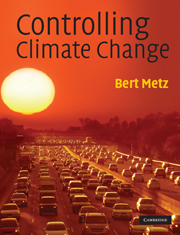Book contents
- Frontmatter
- Contents
- Preface
- 1 Climate change and its impacts: a short summary
- 2 Greenhouse gas emissions
- 3 Keeping climate change within sustainable limits: where to draw the line?
- 4 Development first
- 5 Energy Supply
- 6 Transportation
- 7 Buildings
- 8 Industry and waste management
- 9 Land use, agriculture, and forestry
- 10 How does it fit together?
- 11 Policies and measures
- 12 International climate change agreements
- Index
- Plate section
1 - Climate change and its impacts: a short summary
Published online by Cambridge University Press: 05 June 2012
- Frontmatter
- Contents
- Preface
- 1 Climate change and its impacts: a short summary
- 2 Greenhouse gas emissions
- 3 Keeping climate change within sustainable limits: where to draw the line?
- 4 Development first
- 5 Energy Supply
- 6 Transportation
- 7 Buildings
- 8 Industry and waste management
- 9 Land use, agriculture, and forestry
- 10 How does it fit together?
- 11 Policies and measures
- 12 International climate change agreements
- Index
- Plate section
Summary
What is covered in this chapter?
The climate has changed. Human beings are responsible. And the climate will change further as energy use, agriculture, deforestation, and industrial production continue to increase. In the course of this century it could get up to 6 °C warmer, with more heat waves, droughts, floods, and storms. As a result a wide range of impacts can be expected. Food production and water availability will diminish. Nature will suffer, with a large percentage of species threatened with extinction. New health problems will arise. Coastal areas and river deltas will face more floods. The overall effect of this will be devastating for poor countries, undermining their efforts to eradicate poverty. But even rich countries will see the costs of these impacts rise to significant levels.
The climate has changed
Climate can be defined as ‘average weather’, so it covers averaged temperatures, rainfall and wind direction and speed. Usually this is averaged over a period of 30 years. Let's have a look at how temperatures, rainfall, and wind have changed since 1850.
From the temperature measurements across the world (see Box 1.1) it is clear that global average surface temperatures have gone up about 0.8 °C since the the pre-industrial era (or since about 1850). This happened in two stages, between 1910 and 1940 (about 0.35 °C) and from the 1970s till the present (more than 0.55 °C), with a period of slight cooling (0.1 °C) in between. The change is getting faster over time (see Figure 1.1).
- Type
- Chapter
- Information
- Controlling Climate Change , pp. 1 - 29Publisher: Cambridge University PressPrint publication year: 2009
- 2
- Cited by



